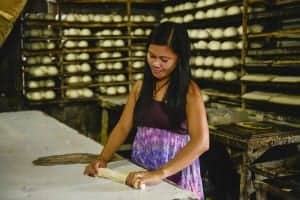Small and medium-sized enterprises (SMEs) are a boon to developing economies in Asia, as they are in the rest of the developing world. SMEs run by men and women comprise a whopping 98 percent of all Asian businesses and are a key engine of economic growth.
SMEs are a backbone of the economies of the Association of Southeast Asian Nations (ASEAN), who this year launched the ASEAN Economic Community (AEC). Recognizing SMEs significance to economic growth, one of the AEC’s goals this year is supporting and building capacity for SME financing, making the question of how to nurture the development of SMEs a compelling one to answer.
Supporting women-owned SMEs is especially important to the region’s growth, concludes “Access to Finance of Women-Owned SMEs in Southeast Asia: An Assessment of Five Countries,” a study Women’s World Banking conducted for the Australian Department of Foreign Affairs and Trade. The study looked at women-owned SMEs in the Philippines, Vietnam, Cambodia, Myanmar and Indonesia and found that while some 23.9 million women in these countries own and run micro and SMEs, cultural and institutional obstacles inhibit their growth.
 Women’s World Banking analyzed existing reports on SMEs and conducted interviews with stakeholders including policymakers, NGOs, and financial institutions, with an eye toward helping banks and other key players in the five countries “better serve the needs of women-owned SMEs,” says Jaclyn Berfond, a Research, Monitoring and Evaluation specialist at Women’s World Banking. “We’ve made a lot of recommendations for actions stakeholders can take to create an enabling environment,” she added, with the hope that there will eventually be “an ecosystem for supporting women-owned businesses in these markets.”
Women’s World Banking analyzed existing reports on SMEs and conducted interviews with stakeholders including policymakers, NGOs, and financial institutions, with an eye toward helping banks and other key players in the five countries “better serve the needs of women-owned SMEs,” says Jaclyn Berfond, a Research, Monitoring and Evaluation specialist at Women’s World Banking. “We’ve made a lot of recommendations for actions stakeholders can take to create an enabling environment,” she added, with the hope that there will eventually be “an ecosystem for supporting women-owned businesses in these markets.”
What’s barring women-owned SMEs in Southeast Asia from accessing finance?
An estimated 33 to 66 percent of SMEs are owned by women in four* of the countries studied, however only a small fraction are well served with financial services (around 3 to 21 percent). Improving access to financing and non-financial services for women would boost the entire ASEAN region. A Goldman Sachs report cited in the study says closing the credit gap in 15 countries alone by 2020 (including the Philippines, Vietnam and Indonesia) could mean a 12 percent gain in per capita incomes by 2030.
Women-owned SMEs are, generally, poorly served for many reasons. Some women prefer informal sources of financing, which are perceived to be more easily accessible than formal credit. Some opt to keep their businesses small, due to responsibilities in the home or because they prefer to invest their resources in their families’ education and health. Some face religious strictures that prevent them from accessing formal financing without the consent of male family members.
But in plenty of other cases, women face limited access to finance, technology and markets, preventing them from purchasing land, machinery, buildings or expanding their businesses.
“If a woman starts a business and she’s relying on informal financing, it’s not going to grow at the rate a formally financed man’s small businesses will grow,” says Jaclyn. “One question is: How do you get women interested?”
How to enable women-owned SMEs’ access to finance

Another tool is strengthening non-financial services. Women need to understand what financing options are open to them, the collateral and documentary requirements involved, and the costs and risks associated with various options. “Can you imagine if you’ve never even been inside a bank? How do you even begin to apply for a loan?” notes Berfond.
Tailoring financial and non-financial services to women’s real needs in individual countries is also necessary. Impediments to services in Cambodia, for example, are not necessarily the same as those in Myanmar. Right now, though, granular information on a country-by-country basis is scarce. To ensure a better fit between needs and offerings – creating products suited to women’s specific, country-based circumstances – better and more data is needed.
As women come into the formal financial sector, governments can gather data that will help service providers compile important gender-disaggregated information on the creditworthiness and risks of potential borrowers. Such data can also help banks’ product development. For instance, Berfond says, “the best way to approach banks is to say: We know there are a lot of women working, say, in textiles, and here are the specifics of what they need.” Until data is gathered more effectively, that can’t happen.
Finally, governments need to actively promote awareness of the benefits of women-owned SMEs. They can do this by creating a policy and regulatory environment that enables women to access financial services and by encouraging banks to increase their stake in women-owned enterprises.
Taking all these steps to support the development of women-owned SMEs in the Philippines, Vietnam, Cambodia, Myanmar and Indonesia will create a tremendous opportunity for the prosperity of women entrepreneurs, their families, and the countries. It will take the combined efforts of the banking institutions, government, NGO and other stakeholders, but in the end the flourishing of women-owned businesses will mean a stronger, wealthier, more vibrant ASEAN economy.
*Myanmar doesn’t have any reported data



